Alejandro Valverde sprints clear in the final straight to win the Flèche Wallonne. An obvious scenario but plenty happened before with numerous crashes. It promises a very nervous Stage 3 of the Tour de France.
As usual an early breakaway but no riders of serious consequence. It took a while to reel them all in even while they were bickering and attacking each other. The race behind was on with crashes as riders fought for position. Tejay van Garderen tried a move over the Côte d’Ereffe and why not? He’s a steady rider rather than the springy type for the finish and was one of the few BMC riders to stay upright.
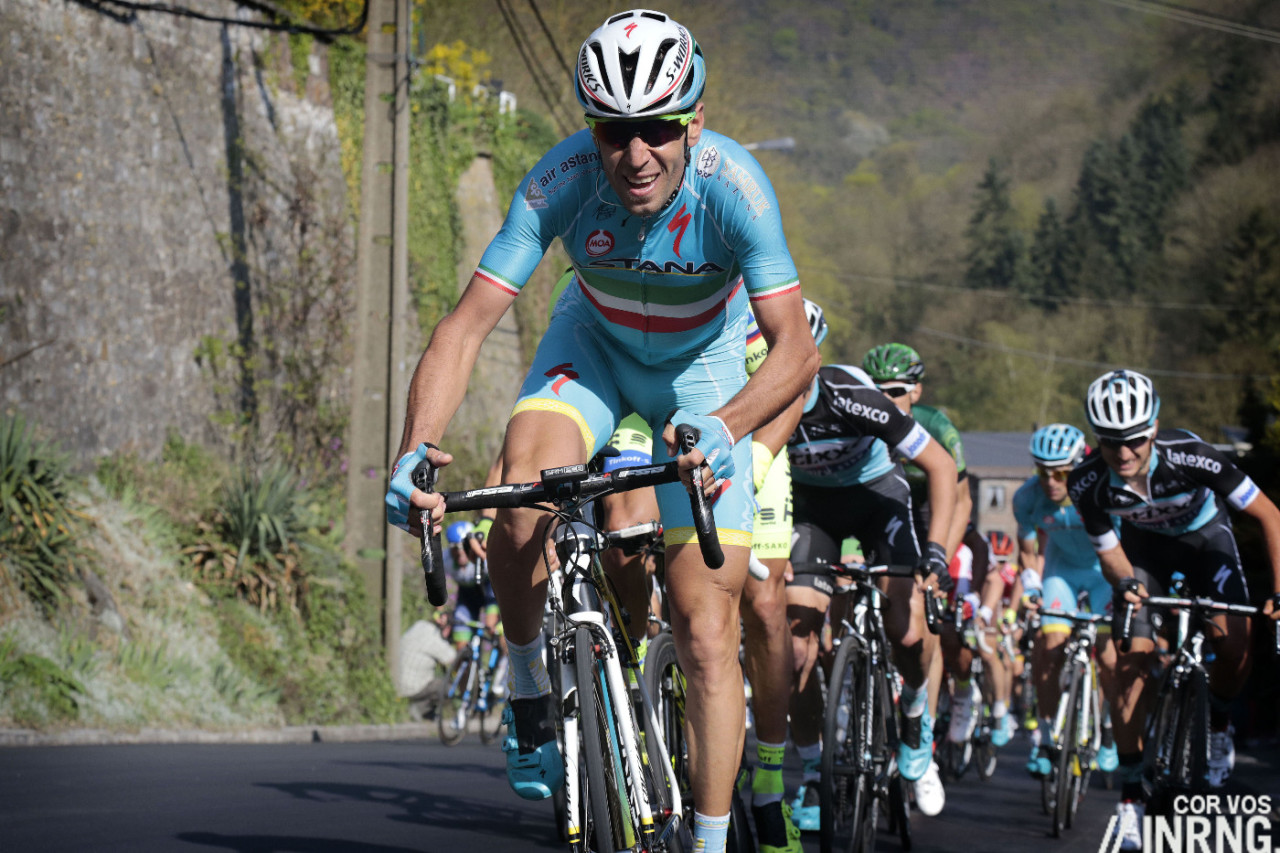
Near the finish we got another Vincenzo Nibali attack and again it was more show than go. As stated in the preview the new Côte de Cherave climb is wide and straight, hardly a launchpad and so any attack is pointless. You can view Nibali’s move generously as a leg-stretcher but otherwise it was a big waste of energy that cost him on the Mur de Huy.
Over the top and Tim Wellens took a lull to jump away, this was able to stick for longer than Nibali’s move, if only because nobody can afford to let Nibali go. But Wellens was always going to be pulled back, the effort needed to go clear and preserve a lead meant he arrived the foot of the Mur de Huy cooked. After the bunch reeled in Wellens Valverde hit the front, not sprinting but just matching everyone else and ensuring nobody could block his path. This time there were no foolhardy attacks with 500m to go, the bunch was huddled but don’t confuse this with riders sitting tight, everyone was surely on the limit. As the finish came into sight the sprint got going with a charge by Orica-Greenedge’s Michael Albasini – in form for his Tour de Romandie – but Valverde wouldn’t let anyone pass and accelerated in the final metres.
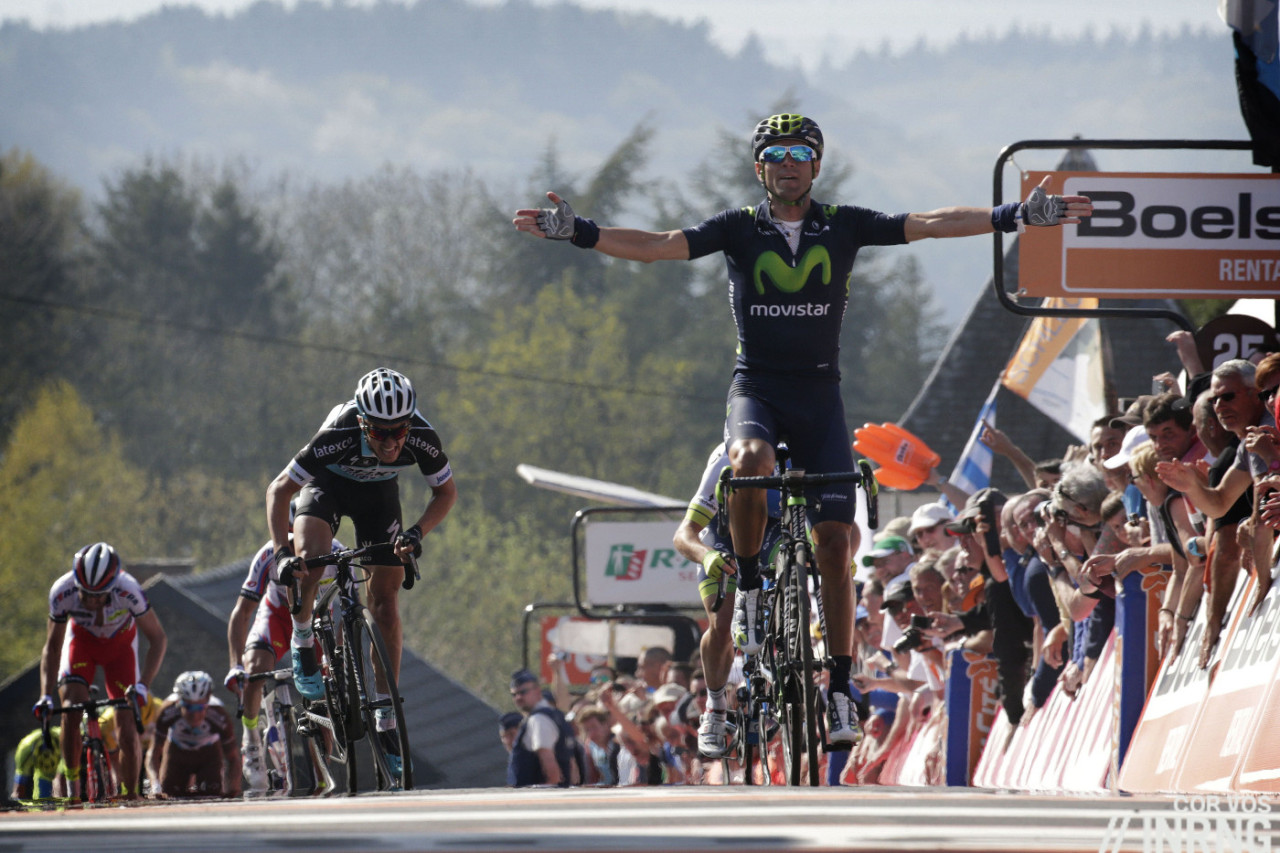
The Verdict: the addition of the Côte de Cherave helped liven up the finish but this remains a race where hours of live coverage bring nothing except crashes and doomed breakaway bids. You can tune in for the final 10 minutes and miss nothing meaningful and then watch things unfold with almost no tactical sophistication and the TV cameras don’t do a great job of conveying the gradient. The linear way the riders went up the final climb made the finish even less exciting, there were no spectacular implosions with riders surging and fading.
Valverde was the prime pick in the preview to win the race but he’s never a first choice winner for many, his cries of “injustice” when the Italian Olympic Authority (CONI) succesfully banned him for his involvement in Operation Puerto still echo no matter how elegant he can be at times on the bike. He joins the club of three winners with Marcel Kint (1943-45), Eddy Merckx (1967, 1970, 1972), Moreno Argentin (1990,1991, 1994) and Davide Rebellin (2004, 2007, 2009). There’s room for a fourth but he turns 35 on Saturday as as much as his team will delight in the win he’s secondary to Nairo Quintana’s ambitions now. The Colombian finished 76th today.
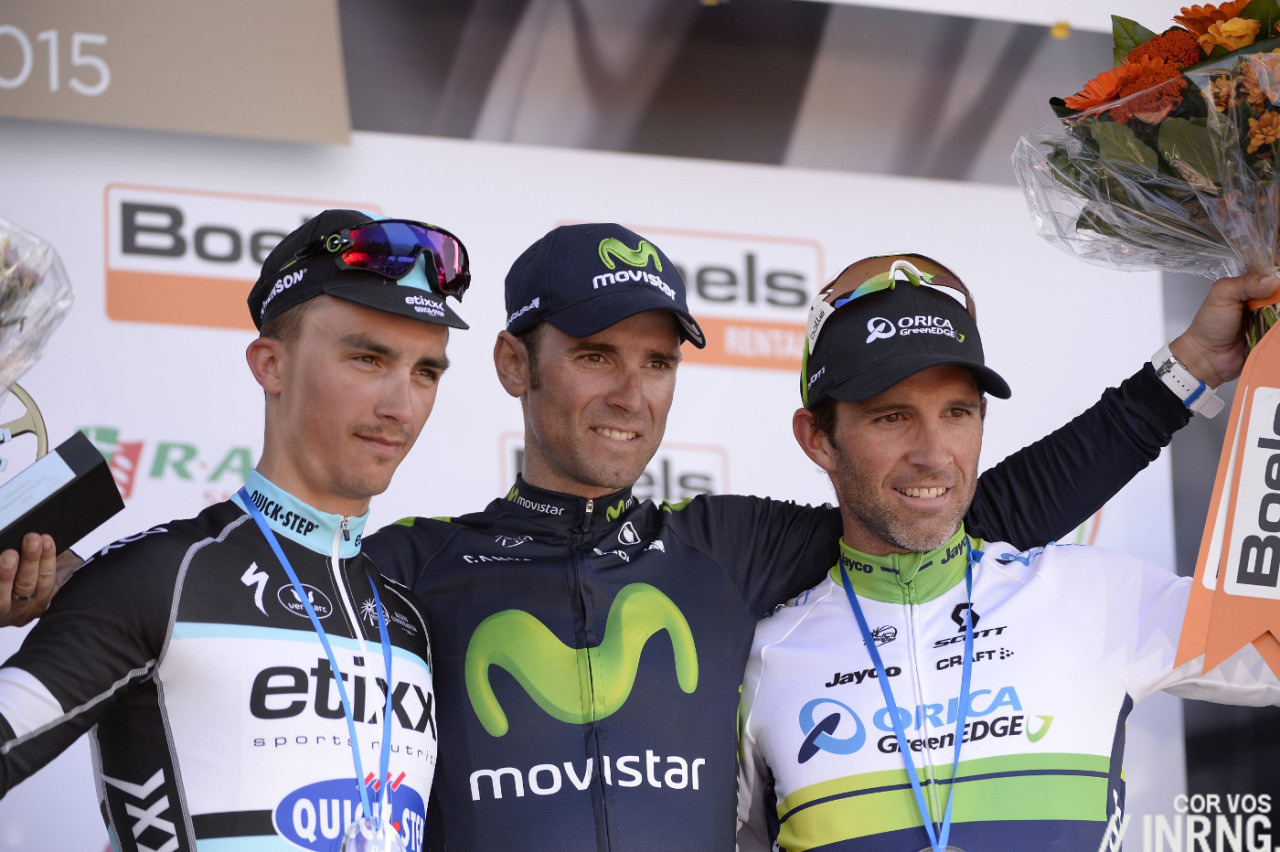
Another winner was the Côte de Cherave which proved a successful addition, thinning the field down and adding some more spice to the finish. It left the main contenders in place but got rid of many of their team mates. All day the likes of Katusha, Movistar and Team Sky had been working but after Cherave the big names didn’t have much support left.
La Flesh Wound: the race was marked by several crashes:
- Dan Martin was one of the first and the logic of 6th-4th-2nd in recent years was respected with a zero out of today’s race. Don’t rule him out for Liège though, he was up and running today and he crashed in the Amstel Gold Race last year before bouncing back to better results
- Another crash took out two of Team Sky’s outsiders in Wout Poels and Lars Petter Nordhaug and if they weren’t going to win they were needed to place Segio Henao
- Philippe Gilbert was out too, again he was down and got up but when he rode off you see his heart wasn’t in it plus half his backside has hanging out of his shorts and if his injuries didn’t get the better of him perhaps dignity did
- Next in the demolition derby of contenders was Lotto-Soudal’s Jelle Vanendert who was left sitting stunned in the road
- Then Chris Froome was caught in a crash, his shorts ripped. He started riding but set off so slowly things didn’t look well
- For obvious reasons star names get mentioned but in a way they’re always ok, it’s the lesser riders who sustain injuries that put their place in the team, in work even, in jeopardy. Katusha’s Alexey Tsatevich in particular seemed very badly off but many riders fell.
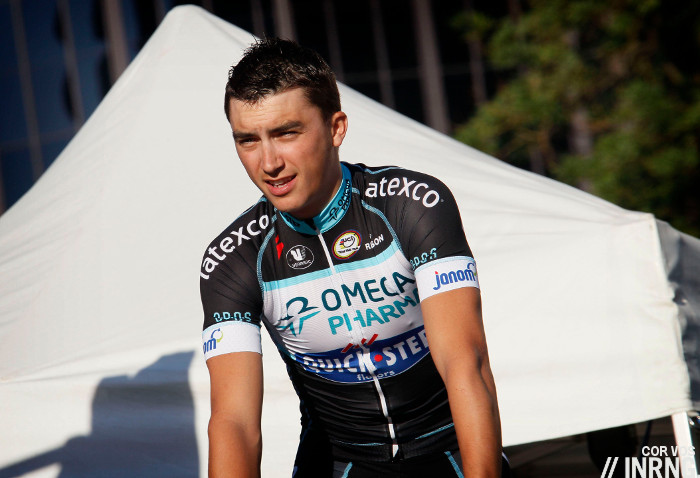
Second place went to 22 year old Julian Alaphillipe of Etixx-Quick Step. A second-year pro he came to the fore last year finishing third, fourth and second on the flatter stages of the Volta a Catalunya. A sprinter? No, he won a summit finish stage of the 2013 Tour de l’Avenir. He’s a punchy finisseur and was fifth in the GP Plouay last year too, proof he can handle the distance of a World Tour race. He’s been training for the Ardennes races with 300km/8hour rides around his home town of Montluçon, a dull place in central French which is also home to Roger Walkowiak. Today Alaphilippe called second place “a defeat”, fighting talk when so many compatriots announce bland ambitions of a top-10 in the Ardennaises.
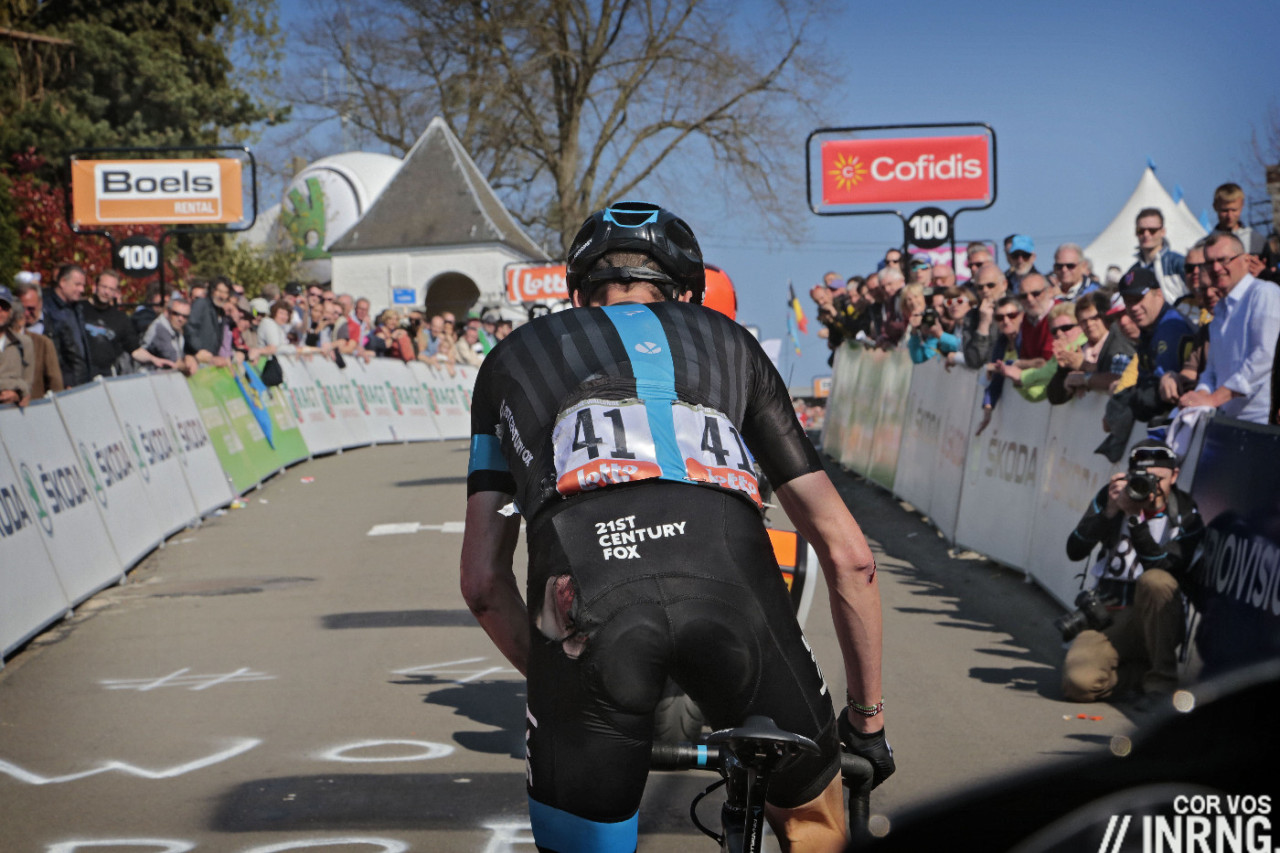
Project (to) July: if today was a crash-fest imagine what it’ll be like in July with more riders, an extra man per team and the added pressure. They’ll be a yellow jersey to defend, GC candidates to place at the front out of trouble, riders scrapping for the stage win plus a peppering of have-a-go heroes risking it all for little more than 15 seconds of TV air time. If the Côte de Cherave dropped many today then it’ll leave plenty floundering July and if anyone is distanced on this climb they risk losing more time on the descent and then the Mur de Huy. One mistake or one crash and someone can lose a minute or more. Today Chris Froome finished 123rd and 12 minutes down, not the kind of recon experience he wanted.

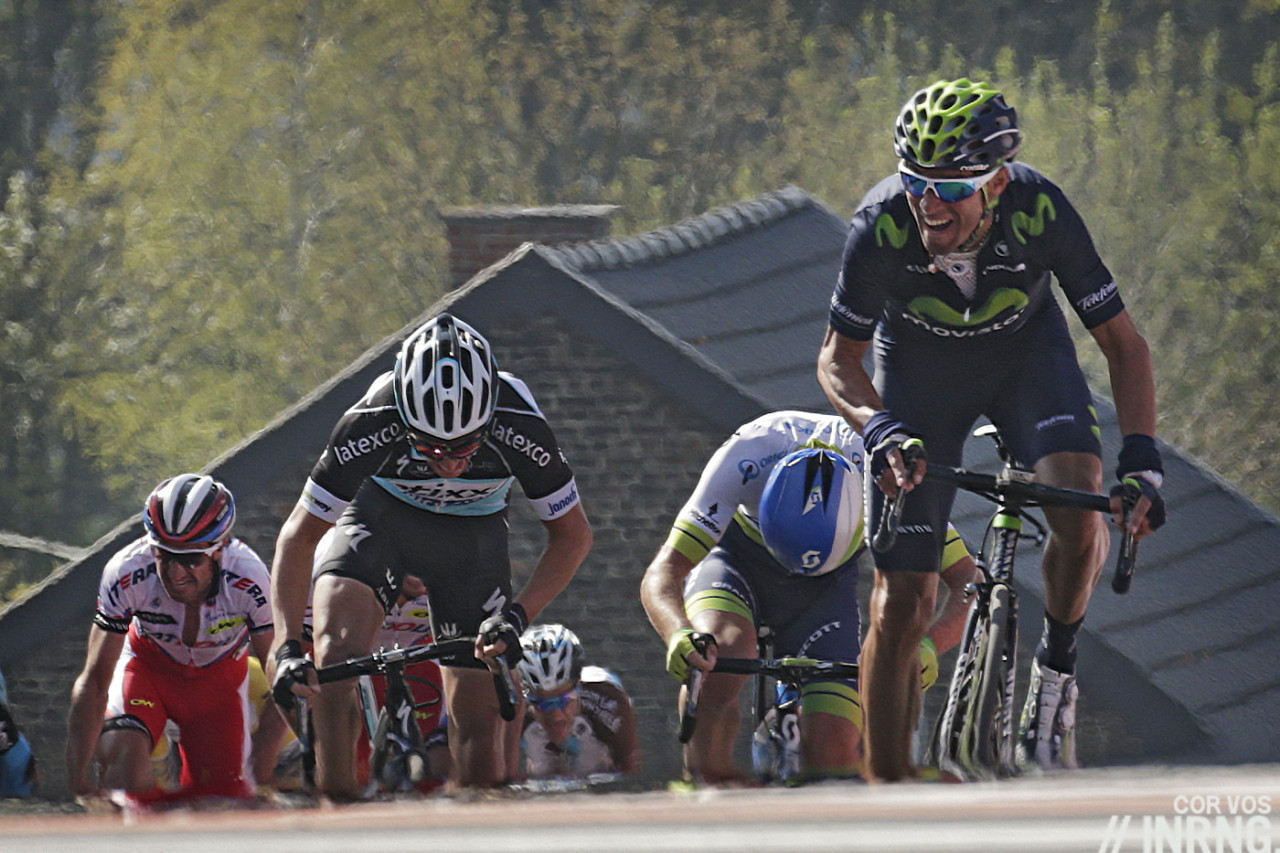
A really bad day for BMC especially with not only Gilbert but also Sanchez hitting the deck. Sky on the other hand can console themselves with not only a top 10 here, but Porte absolutely crushing it at Trentino.
I know BMC Racing’s Wyss and Moinard crashed too. The team says Gilbert should be ok for Sunday.
Some static cameras at road side level on the final climb would have helped convey the difficulty, its not rocket science is it. These massive boom cameras such as used in MOTOGP have their uses but they kill the sense of speed of the bikes, but tv directors are obsessed with them.
While a static camera seems obvious, it is a short-sided investment in a shot that will only last a couple of seconds. Deploying cameras that can deliver either multiple angles or a longer shot will always win out. If it were a circuit race, then yeah, that static camera would be useful on multiple laps and certainly give a better sense of gradient. It is always easy to say “hey, throw on another camera!” but the cost of that extra camera is significant. You need cameras/angles/assignments that give you more bang for your buck.
I’d say considering how the Mur is the focal point of the race and they climb it more than once, I’d say it’s worth it
God, this season gets worse and worse. Even the mur de huy was boring, nothing happened until the last 100 meters. Really preffered Purito or Gilbert’s wins.
On TV it seemed slow, any idea of the time employed compared to other years?
I predict a 50+ bunch sprinting for victory in Liège…
Mur de Huy
2015:1 km@11,1%—2:53—average speed 20.81 km/h(Alejandro Valverde)
2014:1 km@11,1%—2:41—average speed 22.36 km/h(Alejandro Valverde)-RECORD
2013:1 km@11,1%—2:48—average speed 21.43 km/h(Daniel Moreno)
2012:1 km@11,1%—3:00—average speed 20.00 km/h(Joaquim Rodriguez)
2011:1 km@11,1%—2:44—average speed 21.95 km/h(Philippe Gilbert)
2010:1 km@11,1%—2:45—average speed 21.82 km/h(Evans-Rodriguez-Contador)
2009:1 km@11,1%—2:46—average speed 21.67 km/h(Davide Rebellin)
2008:1 km@11,1%—3:02—average speed 19.78 km/h(Kim Kirchen)
2007:1 km@11,1%—2:45—average speed 21.82 km/h(Davide Rebellin)
2006:1 km@11,1%—2:51—average speed 21.05 km/h(Valverde-S.Sanchez-Kroon-F.Schleck)
2005:1 km@11,1%—3:01—average speed 19.89 km/h(Di Luca-Kirchen-Rebellin)
2004:1 km@11,1%—2:46—average speed 21.67 km/h(Davide Rebellin)
The interesting thing was until 2004 it was never under 3 minutes, from what I saw. Before then it was virtually always small groups which arrived at the base of the Mur, and a combination of fatigue from being in the break, lack of draft on the lower portions, and generally larger gears on bikes then resulted in slower times, even in the flying ’90’s.
It’s remarkable how this race has swung from being a war of attrition to a pack sprint. Carlton on Eurosport was talking about there being “only 25” left at the end. Before 2004, that was virtually unheard of: always less.
Thanks for the info.
We can indeed consider it as a moderately slow Mur. Maybe it is due to the addition of Cherave?
Anyway, still impacted by the passivity of the riders on the climb. They really accelerated when the last turn was there. The young 1st year pro Theuns was still in the front line at that moment, but then he lost ground and finished 13th.
I hope I am wrong, but I guess this announces a very boring Liège as well.
It may have been below average for the past 12 years but Kelderman, top ten and 4 seconds down on Valverde, got the Strava KOM and that’s more important than any race result.
Personal observations and judgement says by far the dullest and most predictable race of the ‘classic season.
A winner who’s reputation does the sport no favours.
Kwiatkowski not on his best today. Can see him talking with Alaphillipe just before the Mur presumably giving him the go ahead? Etixx by far the most consistent team this spring. Maybe lacking wins but they have a lot of depth. As much as I like Valverdes style he is and will be marred by his past and I trust him as much as Vinokurov or Mexican tap water… Not the most exciting of races but will build curiosity ahead of TdF stage.
Valverde and Albasini look like twins!
I’ve never clocked that before – you’re right, they do!
Secret twins!!! Albasini’s blood in Fuentes’ bags!!!!! HE was Valvpiti!!!!!!!
Now everything starts to make sense…
(need I to insert a smiley here?)
🙂 You just made my day, thanks gabriele!
The post EPO era these races can seem lifeless and dull, sad but i fear true.
The Flèche Wallonne wasn’t that exciting then either, breakaway in this race are rare and so the traditional scenario is an uphill sprint.
I think the EPO era was still worse:
https://youtu.be/D3rZphEtzSM
That was just taking the biscuit.
Seems legit…
Why did somebody have to post that video!
I always feel empty and violated after watching it.
Apologies, just don’t want people getting too nostalgic for the 90s.
Surely it’s the ‘less EPO’ era now? It’s very clear that Ferrari et al are still involved with huge links to Astana and Movistar to name just two teams. I suspect it is the majority of teams still, certainly many of the top riders.
Yes, this era will be remembered as the “micro-dose era”. But the vast majority of pro-riders are still doping — clearly. (I hope that’s not a controversial statement any longer).
Evidence? Or just the Di Luca-like comments made by one rider on CIRC?
Personally i’m less convinced about Cherave than INRNG. It wiped a lot of the peloton but clearly put a lot of the remnants more into the red than they might have liked. By the time Wellens demise was assured it looked like they were saving energy even on the Muur itself (but then again this might just have been cameras). Certainly no-one even thought about a long 500m sprint and even the final 200m weren’t explosive. If we are still going to have no action at least have 3 minutes rather than 200m.
Somehow the race that only has expectations of 500m, 3 minute burst of excitement managed to fall short of that. Cherave is too open and too flat in the second half to attack and it just blunted too many of the leading group. Valverde played it perfectly but the number of “diesel’s” in the lead group says a lot about the race. FW is unlikely to give us big action without a serious shake up and i’m used to that by now, but still today was jus a massive dissapointment.
Conversly the Womens race was action packed with multiple splits and long range attacks. Van der Breggen solo’d her way to a late attack and then held on up the Muur, it was everything the mens race should be!
Saying this will send Larry T into paroxysms of indignation, but none the less one of the best one day races so far this season has been the Cadel Evans Great Ocean Road Race.
Strada Bianche was cool
While I’d love to entertain you with “paroxysms of indignation” I didn’t see any of the Cadel Evans race so to comment on it’s place on any “best race of the year” list would be unfair.
It’s available on Cycling Hub if you’re interested and have some free time. Obviously it’s far too soon to be talking best races of the year, but if you like one day racing where the the last half of the race was totally unpredictable and the list of potential winners was very long indeed, this had it.
that was a good race…open, attacking. Enjoyable.
Kelderman’s power data are accessible on his Strava feed:
http://www.strava.com/activities/290453084/analysis/17983/18185
Indeed the final Mur, where Kelderman set the KOM (note the Strava segment is longer than the 1 km for which data are reported above), his power ramps up toward the finish, only fading slightly in the sprint where the grade levels out. It was very much a “negative split” on that climb.
Seems like you could get most of the same effect without the crashes if you had them all warm up for 5 hours on the trainer and then did a mass sprint up the Md’H.
The finale was really tarnished by the absence of Gilbert and Dan Martin. Any news about Martin’s health?
Given all the crashes today, Simon Gerrans looks very wise to have skipped FW. Maybe his odds of a repeat at LBL just increased?
I would doubt it. He has had no preparation at all so would be a very long shot in my book.
Doubtful re Gerrans. His powerful sprint after a long hilly day requires more fitness than he has at the moment. Greenedge will play it long with Clarke or at the finish with Matthews.
re projecting to July and more riders / risk of more crashes – surely there will be less riders with an interest in the stage? eg I could see Alpecin and Ettix just spinning it in the back (depends on the make up of the teams if course), and some riders may just choose to limit losses rather than fight to be the first over the line.
Anyway, should be an intriguing stage in July nevertheless.
Huh, what’s up with our much-valued blogger? Have I ever read so much negativity in one of your articles? Are you ready for holidays or had a stressful day at work?
Yes, this race took the course that was expected. As many others do, like M-SR for example. But then you, please correct me if I’m wrong, were against all changes to the route which could liven up things. A classic deserves having a special character, right? Well the Flèche Wallone has exactly that. You know in advance how it will end. If you dislike that what’s the point of even reporting about it?
Montluçon, a “dull” place? Then the majority of towns in France must be dull? Do you prefer bigger cities? I for one am happy that France has so many towns like Montluçon and only a very few Marseilles, Lyons and Paris – which I personally find horrible places to live in but would not state that as a fact (just to name bigger cities in France, there are even much worse places to live in every other European country for my taste).
Valverde is by far the most accomplished rider in cycling now, usually highly competitive from February to October. And when looking for a predecessor of his calibre and universal talent only Sean Kelly comes to my mind, although his capabilities were a little bit different to Valverde’s. He’s in his 13th season but still he does not seem to degrade. He’s still f*#!ing fast in sprints and able to climb with the best in the high mountains. Which is amazing (in the positive meaning of this word).
Yes, he did dope, a (past) failure he has in common with most of his contemporaries. As opposed to them he was caught, kind of. He refused to admit his doping as mostly all the others did who were not yet caught or convicted. And I assume that we are on common ground that there are still many of them in the sport with a tainted past be it as riders or in other roles.
In contrast to them Valverde was suspended and served his suspension. So now he’s entitled to race (again) as anyone is entitled to live on after he paid for committing a crime or a civil violation. Do we really have to deal with him being the bad boy over and over again? He has at least paid for his offenses compared to many others who are still racing or retired but kept in high regard (Indurain, just to name one) and don’t attract mostly negative comments.
Today he was by far the best of those who stayed on their bikes, chapeau! He will feature again on Sunday, better not bet against him, ’cause he finally might have got the cool head he seemed to lack so often in race finals in the past.
Alaphillipe was also very impressive. I have to admit that until today I did not estimate him to be that good yet, but I’m happy for French cycling that they have another strong young gun.
Love it, great response! Sick of the anti-Valverde crowd. Apparently the sentence needs to be ban + a hands and knees repent for all the couch slobs who couldn’t touch him if they were doped to the gills and he was clean as angel boy wiggitty-wiggitty-whack!
Valverde would get a lot less grief if he had admitted it. Unrepentent dopers stick in one’s craw.
Sorry, ‘unrepentant’.
Although if I was Valverde I’d have raged at the injustice of having to adhere to the rules of the dictionary.
Fair summary of Valverde, everyone has to deal with that.
For the race it’s just a repeat scenario every year, it’s like going to the theatre to see the same play every year. You know the plot and the ending and the cast doesn’t change that much either. We still watch of course. As for Montluçon, trust me it’s not an inspiring place!
It’s not the doping that leaves the stain on AV’s reputation. It’s the complete lack of remorse.
Precisely
+1
And while Valverde is entitled to race after serving his suspension, it shouldn’t surprise you that many cycling fans don’t rejoice in an unrepentant doper winning. And to respond to STS, doping is not a “civil violation” like a parking ticket, it’s cheating and should always be labelled thusly.
A+1000. A total lack of remorse should raise questions in any thinking persons mind. For this reason alone Valverde will remain a stain on the sport.
This supposed psychological insight is just nonsense. Somewhere between “Madness and Civilization” and “Discipline and Punish”.
Add to that a nearly absolute ignorance of most facts regarding that infraction (an ignorance which we all share, but – I suspect – someone “more absolutely” than others).
For example, and I’m note necessarily speaking of Valverde, if we want to consider a moral level (which I think it’s generally inappropriate without more direct or detailed knowledge of a situaton) it’s not the same to go desperately around looking for EPO or to be a neo-pro in a team which ruthlessly practises team doping, even against its riders’ will, or to organise a conspiration.
We know that Fuentes had a bag of his blood plasma.
Probably forced by his ruthless team, though: piti Valverde.
😉
Anyway, it’s Valv-pity Valverde. People usually think that his codename was “Piti”, like Basso’s “Birillo”, but it actually was “Valvpiti”. One of the better guarded secrets, I’d say.
And – as a sidenote (again, not strictly about Valpiti) – what was going on in some teams is not something we’d happily joke around with (so to say… actually, I think we can joke about anything, more or less 😉 ).
I’m always quite surprised by people who like to take a moral stance and then focus on cheating, when that aspect is totally secondary when compared to health-damage. Which is quite a complex question, because even when a rider “knowingly” and “freely” takes drugs (which isn’t always the case for one or both the adverbs, we should remember), the extent of that knowledge and of that freedom is yet to be seen.
This shouldn’t be intended merely as a defence of the riders or any rider, but as a way to underline how much of a complexity the simplistic “cheaters” perspective is overshadowing.
+1
Given the strong reactions of those who damn Valverde & others for their “cheating” during those times when nearly everyone else did more or less the same I can’t help but think that it is first and foremost that they as fans or observers of the sport feel “cheated” by doping athletes.
I don’t want to comment further on this attitude because every possible thought that goes through my mind with regards to this might come across as insulting to someone who as a spectator feels “cheated” by an athlete.
STS, everyone is cheated – competitors and spectators alike. And competitors are stolen from – prize money, contracts, etc.
‘Everyone else’ (of course a small minority weren’t) doing it is not an excuse: you’re still guilty if you do it. Two wrongs don’t make a right.
This sort of attitude is put forward by the ‘level playing field’ proponents.
The playing field is never level. For it to be level:
– every rider would have to be on all of the different drugs
– at the same doses
– taken to the same regime
– with the doses adjusted to bodyweight.
And even then, it wouldn’t be a level playing field, because different people react to different drugs in different ways.
Therefore, one can never say that a drug user ‘won’ a race.
@J Evans
I did not talk of a level playing field and I do not consider doping to create a level playing field so we can exclude that from our discussion.
Those riders who did not dope during that era have all rights to claim that they were cheated, there’s no doubt about it. But those were less than 10, probably less than 5%. That does not make doping right, but it puts things into context.
I know I have no means to proof it to you but from what I know by talking to riders of that era and from reading interviews the vast majority of his competitors still consider Lance Armstrong to be the winner of those TdFs and don’t feel cheated by him. That includes a lot of them who did not like him as a person or a competitor. A considerable number of them feel “cheated” by the UCI though whom they blame for not doing enough to make sure the anti-doping rules were followed thus creating a situation where they had to choose between getting out of cycling and risking their income or doping themselves.
As you confirm that point of view again please try to explain how those riders cheated the spectators, be it those on the roadside or those watching the race on TV. I really still have to understand the reasoning for that claim. But I reckon you are analytic enough to help me understand it.
STS:
Agreed: it was less than 5% and the UCI did cheat the riders.
As for your questions:
The riders cheated the spectators, in my view, simply because we can never know who would have won those races in a ‘clean’ world. (And yes, I know a clean world doesn’t exist now and never has, but that period was particularly extreme.)
To use the Armstrong example you bring up, there is no way anyone can know whether he was a great cyclist or a mediocrity with a superior drug regime (or anything in between those two extremes). For me, personally, that’s a real shame. Others might just not care – but plenty seem to. (The sheer extent of drug use in that era means that this is more the case then than at any time before – when the drugs just weren’t as good – or since – when the testing was better.)
Lemond – far from unbiased (about as far as one can get, I imagine), but knowledgeable – reckons that Armstrong was a mediocre rider. But I don’t think he can know any more than anyone else can – including those riders you mention.
Crucially, whenever I hear a rider talking about how Armstrong ‘genuinely’ won those tours and was a great rider, I always think ‘Whose doping are you trying to justify?’
A. Schleck, JVD Broeck, S. Sanchez, Contador all came out in support of Armstrong (notable that younger riders didn’t) – and I think that said a lot more about them trying to protect their own reputations (to themselves as much as to others) than anything else.
How much would Moncoutie have won if everyone else had been as clean as him?
I thought it a bit pathetic, seeing TJV making a C- effort after BMCs chances were littered along the road.
tbf (and I’m no Tejay fan) at least he gave a hit out, rather than just sitting in wheels
That this race falls on a Wednesday, after a grueling Amstel Gold and before the last chance saloon of the spring classics, L-B-L, it makes sense that it lacks some excitement until the end, whether due to riders lacking energy or saving energy. For a Wednesday race, I’ll take it!
It was a boring race. The peloton had the break well controlled. Watching people fall off their bikes provided a little interest. Then the bunch came to the Mur. Which is cool to watch, for sure, but still it only lasts three minutes. Actually, not even three minutes of pushing and grimacing, and then it was over. Just a wham and a bang, that left me laying there, asking “is that it?”, while the Fleche got up, dressed, and left. I guess I’ll have a cigarette and go to sleep.
Valverde must be one of these riders mentioned in the CIRC report that doesn’t believe he’s a cheat because he’s never been caught positive.
Great ride again by Alaphillipe, after his 7th place on Sunday, he is now 2nd. Could we French finally have the world class puncher we have been waiting for for ages?? With Pinot, Bardet & Barguil in the mountains, Senechal and maybe Demare in the classics, we potentially have Alaphillipe and Gallopin as punchers. Great future for French cycling.
Vuillermoz did a good ride too, he crashed but recovered to finish sixth and all with a broken wheel that was rubbing on the brake blocks as he rode uphill.
5 years in a row for Canyon!
Amazing. they’ve chosen wisely with their World tour teams. Valverde always gets screen time, Quintana too. Rodriguez and Kristoff for Katusha.
In the UK their bikes are going from strength to strength, though the CF SLX is pretty fragile.
Canyon is certainly having a pretty good time this spring; alongside this five year mark in F-W.
True as it is that the Flèche is getting (?) boring, nevertheless I think it can legitimately survive as a race on his own, a mid-week race for uphill-sprinters. We do have a certain number of lesser Classics who are more or less doomed to finish with a (flat) mass sprint. And a certain Monument sometimes walks down the same path, still we find good motives to appreciate it.
The evolution of the Ardennes’ Classics is worrying, indeed, but the Doyenne now is in greatest troubles, since the “uphill sprint” status is conflicting with its long-term idendity. And the Lombardia, too, took a dangerous turn when he moved to Lecco, and, again, in the renewed Bergamo course, because of the conservative design which really “betrayed” the spirit of the race (despite a good lot of possibilities to draw that course otherwise…).
We’re maybe getting more and more irritated by the Flèche since it emphasises a shared trend, but I’m not so sure that the urgency concerns it as much as other races. If there were ideas, space and occasions to make it better, I’d welcome the change (the new côte looks slightly promising), obviously, as it happened with Gand-Wevelgem, greatly restyled; though, I don’t consider a tragedy to keep it as it is, as long as it maintains its “peculiar” nature and doesn’t become an extreme sample of a general attitude.
It’s lasting some 5-10 minutes? (I find it interesting to watch the teamwork and the positioning before the wall, too)… Well, TV gurus who say we need races for a public with a videoclip attention span have something quite good to try and sell. Let’s see if they succeed with this one, to start with (hope they don’t 😛 But it’s a good test for those theories).